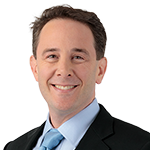Four questions: Why invest in healthcare now?
Portfolio Managers Andy Acker and Dan Lyons cover key investment questions about healthcare.
3 minute watch
Key takeaways:
- Healthcare is a traditionally defensive area of the market that can also boast significant growth opportunities.
- Over the past decade, the gap between the top- and bottom-performing healthcare stocks has been the widest of any sector due to risks such as high failure rates in drug development.
- Long term, the sector’s growth potential looks substantial, as medical breakthroughs lead to new and growing end markets.
IMPORTANT INFORMATION
Health care industries are subject to government regulation and reimbursement rates, as well as government approval of products and services, which could have a significant effect on price and availability, and can be significantly affected by rapid obsolescence and patent expirations.
Actively managed portfolios may fail to produce the intended results. No investment strategy can ensure a profit or eliminate the risk of loss.
1 IQVIA Institute, Global Trends in R&D 2023: Activity, Productivity, and Enablers. February 2023.
Question: How would you describe the healthcare sector?
Andy Acker: When you think about healthcare, it really is quite a diverse sector. And I think it’s important to keep in mind there are some stocks within healthcare that are highly defensive. And these could be large-cap pharmaceutical companies, medtech companies, HMOs. What makes these companies so defensive is that the demand for healthcare is fairly inelastic even during an economic slowdown. When we get sick, we need to go see a doctor.
On the other hand, you have so much innovation happening in the sector. And in fact, it’s like nothing we’ve ever seen before. This could be a record year for new product launches, and that’s really being driven especially by small- and mid-cap biotech companies. This is where two-thirds of the innovation comes from, and the new products that are in development are coming from these small companies that are often not well represented in the large healthcare indices.1
Question: How do rising costs impact the outlook for the sector?
Dan Lyons: Whenever we’ve seen these innovative therapies that Andy was talking about coming out, we’ve seen healthcare systems around the world figure out ways to pay for them. So, whenever you’re really changing the practice of medicine people are willing to pay for that.
Acker: Let’s think about obesity. Obesity has been a growing, really epidemic, not just in the United States, but around the world. And they cost much more to treat. When we think about heart disease, cancer, diabetes, liver disease, kidney disease – virtually every disease you could get is increased by being substantially overweight.
So now, we have new therapies that for the first time can give levels of weight loss that we’ve never seen before. So, we have therapies that are given once a week injectables, or once-daily orals that are in development, that are reaching 15% to 20% weight loss.
Just very recently, we’ve had data now called the SELECT study that showed for the first time that just losing weight alone is enough to drive an improvement in cardiovascular outcomes. So, we’ve seen a 20% reduction in heart attacks and strokes and cardiovascular death. That means we’re going to have substantial savings by using these drugs.
Question: How can investors reduce their downside risk in the sector?
Lyons: I think, oftentimes, benchmarks don’t adequately capture these great sources of innovation. And that’s what really creates the opportunity for investing in an actively managed fund within the sector. Because healthcare has the widest disparity between the winners and the losers, and if you’re just investing in a benchmark, you’re getting a lot of exposure to all those losers.
Question: What’s an example of healthcare’s growth potential?
Acker: If we think about surgery, robotic surgery, less than 10% of procedures today are done using the aid of a robot. And yet, with a robot you can be more precise than the human hand. You can improve outcomes. You can lower bleeding, lower pain. Basically, better in every way for the patient. And again, these are markets measured in the billions of dollars, still less than 10% penetrated. So, we see growth, not just for the next few years, but really for the next few decades. And that’s what gets us so excited in the healthcare sector.
Queste sono le opinioni dell'autore al momento della pubblicazione e possono differire da quelle di altri individui/team di Janus Henderson Investors. I riferimenti a singoli titoli non costituiscono una raccomandazione all'acquisto, alla vendita o alla detenzione di un titolo, di una strategia d'investimento o di un settore di mercato e non devono essere considerati redditizi. Janus Henderson Investors, le sue affiliate o i suoi dipendenti possono avere un’esposizione nei titoli citati.
Le performance passate non sono indicative dei rendimenti futuri. Tutti i dati dei rendimenti includono sia il reddito che le plusvalenze o le eventuali perdite ma sono al lordo dei costi delle commissioni dovuti al momento dell'emissione.
Le informazioni contenute in questo articolo non devono essere intese come una guida all'investimento.
Comunicazione di Marketing.
- Le Azioni/Quote possono perdere valore rapidamente e normalmente implicano rischi più elevati rispetto alle obbligazioni o agli strumenti del mercato monetario. Di conseguenza il valore del proprio investimento potrebbe diminuire.
- Le azioni di società a piccola e media capitalizzazione possono presentare una maggiore volatilità rispetto a quelle di società più ampie e talvolta può essere difficile valutare o vendere tali azioni al momento e al prezzo desiderati, il che aumenta il rischio di perdite.
- Un Fondo che presenta un’esposizione elevata a un determinato paese o regione geografica comporta un livello maggiore di rischio rispetto a un Fondo più diversificato.
- Il Fondo si concentra su determinati settori o temi d’investimento e potrebbe risentire pesantemente di fattori quali eventuali variazioni ai regolamenti governativi, una maggiore competizione nei prezzi, progressi tecnologici ed altri eventi negativi.
- Il Fondo potrebbe usare derivati al fine di conseguire il suo obiettivo d'investimento. Ciò potrebbe determinare una "leva", che potrebbe amplificare i risultati dell'investimento, e le perdite o i guadagni per il Fondo potrebbero superare il costo del derivato. I derivati comportano rischi aggiuntivi, in particolare il rischio che la controparte del derivato non adempia ai suoi obblighi contrattuali.
- Qualora il Fondo detenga attività in valute diverse da quella di base del Fondo o l'investitore detenga azioni o quote in un'altra valuta (a meno che non siano "coperte"), il valore dell'investimento potrebbe subire le oscillazioni del tasso di cambio.
- Se il Fondo, o una sua classe di azioni con copertura, intende attenuare le fluttuazioni del tasso di cambio tra una valuta e la valuta di base, la stessa strategia di copertura potrebbe generare un effetto positivo o negativo sul valore del Fondo, a causa delle differenze di tasso d’interesse a breve termine tra le due valute.
- I titoli del Fondo potrebbero diventare difficili da valutare o da vendere al prezzo e con le tempistiche desiderati, specie in condizioni di mercato estreme con il prezzo delle attività in calo, aumentando il rischio di perdite sull'investimento.
- Il Fondo può sostenere un livello di costi di operazione più elevato per effetto dell’investimento su mercati caratterizzati da una minore attività di contrattazione o meno sviluppati rispetto a un fondo che investa su mercati più attivi/sviluppati.
- Il Fondo potrebbe perdere denaro se una controparte con la quale il Fondo effettua scambi non fosse più intenzionata ad adempiere ai propri obblighi, o a causa di un errore o di un ritardo nei processi operativi o di una negligenza di un fornitore terzo.




